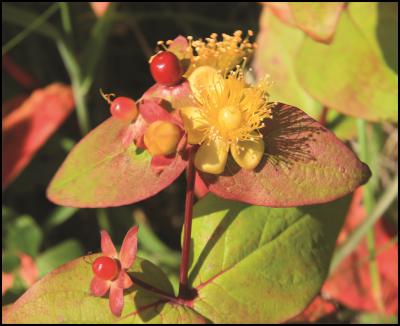Tutsan awareness campaign kicks off in region
MEDIA RELEASE
7 December 2016

Photo caption:
Tutsan has small, pale yellow flowers that have
five petals and prominent stamens. It flowers from November
to February.
Tutsan awareness campaign kicks off in region
An awareness campaign has been launched by Waikato Regional Council, urging farmers to protect their properties from the invasive pest plant tutsan.
It’s in response to the recent rapid spread of tutsan through western Waikato, especially in hill country farming areas, as well as a change to its pest status in the region.
Under the Waikato Regional Pest Management Plan rules landowners are now required to get rid of tutsan from their properties.
“While tutsan has been around for many years it had been held in check by a leaf rust between the 1970s and 1990s,” said council biosecurity pest plants team leader, Darion Embling.
“Worryingly it’s on the increase again and it can have a massive impact on the productivity and profitability of farm businesses if its spread is left unchecked,” Mr Embling said.
Tutsan is spreading rapidly into valuable pastureland, production forestry and conservation land, where it forms monocultures and suppresses desirable plants. It produces large amounts of fine dust-like seed which is easily spread by birds, wind, farm machinery and through mowing of road side verges. Once established it has a very large root system which makes it hard to control.
It thrives on steeper, lower fertility and less intensively farmed land, particularly in the King Country and west coast of the region, up to Te Pahu and Raglan, and on the Coromandel Peninsula and in eastern Hauraki District. Further south, tutsan is a serious weed in Ruapehu district, particularly around Taumarunui, where it favours areas of high rainfall.
Farmers, other rural property owners and roading contractors have an important role to play in preventing the spread of tutsan and other pest plants too by having sound biosecurity practices, Mr Embling said.
“With the help of landowners and contractors, we want to get tutsan under control and stop its spread into farming areas that are currently clear of the pest.
“As part of our awareness campaign we’re contacting farmers directly about the impacts of tutsan and hammering home the message that while it is their responsibility to control, we can help,” Mr Embling said.
Landowners wanting advice on the best way of getting rid of tutsan can call their local biosecurity pest plant officer on 0800 BIOSEC (0800 246 732).
In the meantime, the following measures are recommended to reduce the risks.
• Know what tutsan looks like and the likely pathways of spread to their property.
• Undertake regular and active surveillance for tutsan (and other new or unfamiliar weeds).
• Pull out isolated seedlings as they emerge and replant any bare sites with more suitable plants.
• Clean any machinery leaving your property and be prepared to turn away contaminated machinery that may be coming onto your property.
Tutsan has small, pale yellow flowers that have five petals and prominent stamens. Flowers are followed by round red berries which ripen to black. Its leaves are oval (up to 100mm), turn red-yellow in autumn and smell like curry when crushed.
Visit www.waikatoregion.govt.nz/tutsan for more information on tutsan, including control methods.


 Gordon Campbell: On bird flu, AUKUS entry fees and Cindy Lee
Gordon Campbell: On bird flu, AUKUS entry fees and Cindy Lee Susan Botting - Local Democracy Reporter: Ruawai Leader Slams Kaipara Council In Battle Over $400k Property
Susan Botting - Local Democracy Reporter: Ruawai Leader Slams Kaipara Council In Battle Over $400k Property Te Pati Maori: Another ‘Stolen Generation’ Enabled By Court Ruling On Waitangi Tribunal Summons
Te Pati Maori: Another ‘Stolen Generation’ Enabled By Court Ruling On Waitangi Tribunal Summons Peace Action Wellington: Die In for Palestine Marks ANZAC day
Peace Action Wellington: Die In for Palestine Marks ANZAC day Labour Party: Penny Drops – But What About Seymour And Peters?
Labour Party: Penny Drops – But What About Seymour And Peters? Government: PM Announces Changes To Portfolios
Government: PM Announces Changes To Portfolios Family First: Just 1 In 6 Oppose ‘Three Strikes’ - Poll
Family First: Just 1 In 6 Oppose ‘Three Strikes’ - Poll


